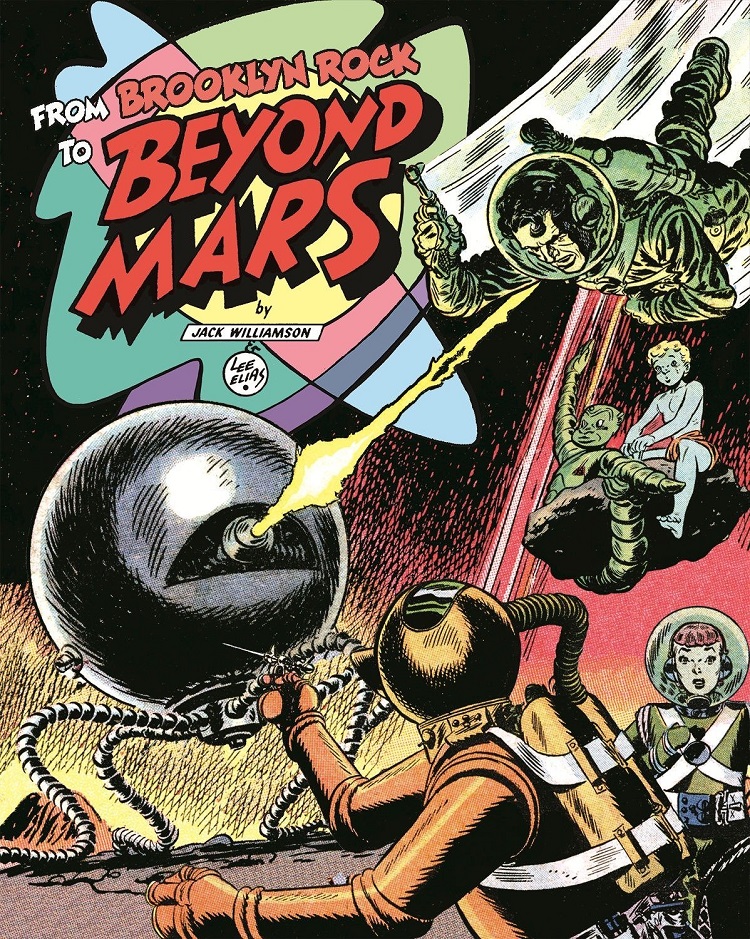
If you’ve never heard of Beyond Mars, don’t feel too bad; the strip was only featured in one newspaper, the New York Sunday News, and it only ran for three years (1952-1955). So there are probably a whole lot of fans that have overlooked the strip and some of them might even be pretty knowledgeable folks. But what it might lack in notoriety, Beyond Mars certainly made up for with pedigree. How many Sunday comic strips can boast one of the architects of the Golden Age of comic books and a Grand Master of Science Fiction as its creative team?
In Bruce Canwell’s introduction, he reveals that although the Sunday News had been riding a wave of success back in those days, the editors saw the writing on the wall. Circulation was dropping and more and more folks were tuning into that new-fangled contraption known as the tee-vee to get their Sunday morning news. One proposed remedy was to feature Sunday strips exclusive to the News.
Editor Ama Barker sought out noted sci-fi author Jack Williamson after reading a review of one of his books which had (unfavorably) compared his space opera to a comic strip adventure. Lee Elias had gained notoriety for his art on the heroine Black Cat for Harvey Comics and was the co-creator of Flash foe, The Fiddler, among various other achievements in the field of sequential art.
Now, I’m gonna take a break here to discuss The Fiddler a little bit. I don’t exactly know how much involvement or input Mr. Elias had on the character, whatever role he played, he should be commended for it. I don’t want to downplay any of the other amazing work Elias has done over the course of his long career and I certainly don’t want to suggest that a Golden Age Flash villain is more important than the accomplishments of a writer who won Hugo and Nebula Awards as well as the World Fantasy Award for Lifetime Achievement and was inducted into the SF Hall of Fame, but… my god.
The Fiddler not only hypnotized people with his musical instrument, he drove around in a car shaped like a giant fiddle! Unabashedly silly and preposterously ridiculous, The Fiddler is like some sort of poster child for nutty Golden Age supervillains. As an aficionado of fun and a huge proponent of goofiness, I’m a big fan of guys like The Fiddler. But I digress. This isn’t a love letter to the Fiddler; it’s a review of IDW and the Library of American Comics’ complete collection of Beyond Mars, an oversized hardcover that includes Canwell’s aforementioned introduction and an exclusive interview with Harlan Ellison about the strip. And it is a thing of beauty.
Rather than focusing on my love of the Fiddler, I should be talking about Lee Elias’ free flowing and energetic pencils, inspired by the legendary Milton Caniff. This is a guy who was a student of the game before becoming a master, who takes full advantage of the medium with a variety of sight gags and illustrations that manage to be both incredibly detailed and humorously exaggerated at the same time. Every page is packed with action and excitement and no one is ever standing still. There are old-fashioned rocket ships and ray guns, bubble-domed space suits and flying saucers. Square-jawed heroes and beautiful women populate the world of Beyond Mars and while this strip is filled to the brim with classic sci-fi tropes, it’s also pretty groundbreaking and creative, even by today’s standards.
Jack Williamson brought a lot to the table during his three short years writing Beyond Mars. It somehow manages to be an interstellar adventure featuring costumed ne’er-do-wells and space pirates while also featuring a frontier town complete with prospectors and roustabouts. Some aspects of the series are fairly progressive by 1950’s standards – the strip deals with drug addiction in the form of “space dust” and even touches on racism when Tham Thmith, a protagonist of Venusian descent, deals with people who judge him by his looks rather than the quality of his character.
Yet other aspects are decidedly old fashioned, such as the “futuristic” ladies decked out in aprons and skirts who exist solely to look good or cook dinner. There’s even a giant, mutated lobster and a mad scientist who can control people’s minds with his high-tech violin (sound familiar?). Beyond Mars features everything and the kitchen sink, but it never feels forced or desperate; it’s just a rollickin’, two-fisted good time that’s increasingly hard to put down and terribly disappointing when you realize how little of it there actually is.
Beyond Mars is Captain Video, Flash Gordon, Terry and the Pirates, and Lil’ Abner all rolled into one exciting package. It’s influence can be seen in everything from Star Trek to Fear Agent. And the quality of these full color reproductions is simply amazing – I have to believe this collection looks better than the original newspaper strips ever did.
Beyond Mars was a new experience for me that felt as familiar and comforting as a warm blanket and as fresh as a newly picked daisy. I highly recommend it to lovers of classic science fiction and sequential art. Beyond Mars is what happens when two masters in their respective fields join forces to create a work of art. It is, simply put, beyond awesome.